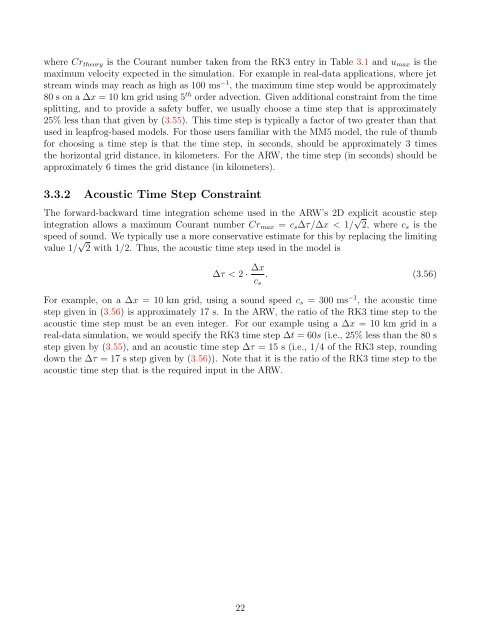Advanced Research WRF (ARW) Technical Note - MMM - University ...
Advanced Research WRF (ARW) Technical Note - MMM - University ...
Advanced Research WRF (ARW) Technical Note - MMM - University ...
You also want an ePaper? Increase the reach of your titles
YUMPU automatically turns print PDFs into web optimized ePapers that Google loves.
where Crtheory is the Courant number taken from the RK3 entry in Table 3.1 and umax is the<br />
maximum velocity expected in the simulation. For example in real-data applications, where jet<br />
stream winds may reach as high as 100 ms −1 , the maximum time step would be approximately<br />
80 s on a ∆x = 10 km grid using 5 th order advection. Given additional constraint from the time<br />
splitting, and to provide a safety buffer, we usually choose a time step that is approximately<br />
25% less than that given by (3.55). This time step is typically a factor of two greater than that<br />
used in leapfrog-based models. For those users familiar with the MM5 model, the rule of thumb<br />
for choosing a time step is that the time step, in seconds, should be approximately 3 times<br />
the horizontal grid distance, in kilometers. For the <strong>ARW</strong>, the time step (in seconds) should be<br />
approximately 6 times the grid distance (in kilometers).<br />
3.3.2 Acoustic Time Step Constraint<br />
The forward-backward time integration scheme used in the <strong>ARW</strong>’s 2D explicit acoustic step<br />
integration allows a maximum Courant number Crmax = cs∆τ/∆x < 1/ √ 2, where cs is the<br />
speed of sound. We typically use a more conservative estimate for this by replacing the limiting<br />
value 1/ √ 2 with 1/2. Thus, the acoustic time step used in the model is<br />
∆τ < 2 · ∆x<br />
. (3.56)<br />
For example, on a ∆x = 10 km grid, using a sound speed cs = 300 ms −1 , the acoustic time<br />
step given in (3.56) is approximately 17 s. In the <strong>ARW</strong>, the ratio of the RK3 time step to the<br />
acoustic time step must be an even integer. For our example using a ∆x = 10 km grid in a<br />
real-data simulation, we would specify the RK3 time step ∆t = 60s (i.e., 25% less than the 80 s<br />
step given by (3.55), and an acoustic time step ∆τ = 15 s (i.e., 1/4 of the RK3 step, rounding<br />
down the ∆τ = 17 s step given by (3.56)). <strong>Note</strong> that it is the ratio of the RK3 time step to the<br />
acoustic time step that is the required input in the <strong>ARW</strong>.<br />
22<br />
cs
















